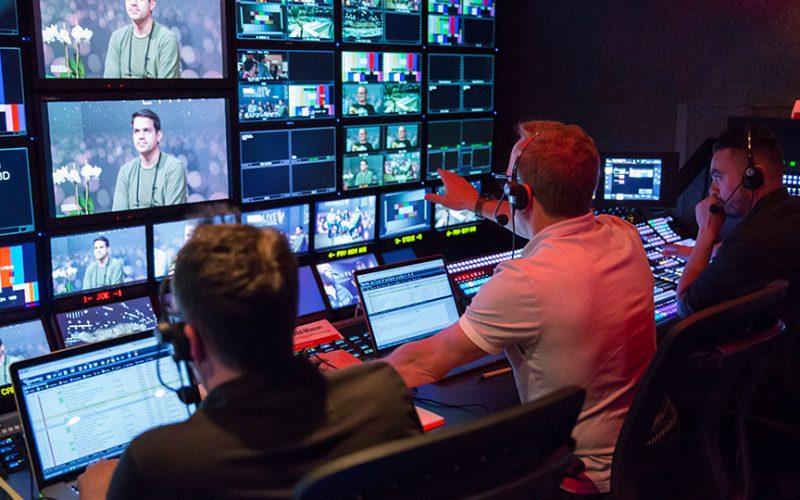Remember your childhood goal of being an exciting news anchor that captivated viewers with breaking stories? I agree. As a media consultant dealing with businesses of all kinds today, I can tell you that broadcast media can be a strong tool, but it also has a drawbacks. Although it has unrivaled reach, deciphering its complexities can be difficult.
Broadcast media, which includes television and radio, is an important source of news and information for a large audience. According to a recent Pew Research Center survey, nearly two-thirds of Nigerians continue to rely on traditional broadcast media for news, despite the advent of digital platforms. This figure demonstrates the ongoing power of broadcast media, particularly in reaching a large and varied audience.
However, despite the promise of broad reach, there are frequently disregarded challenges when moving into broadcast media. Let’s take a closer look at the benefits and drawbacks of this conventional media.
Key Takeaways
- Broadcast media, encompassing television and radio, remains a vital source of news and information, retaining substantial influence despite the rise of digital platforms.
- The process of broadcast media involves creating audio-visual content, transmitting it across various channels, and allowing reception through devices like TVs and radios, with a unique capability for real-time broadcasting.
- Broadcast media offers a multisensory experience that combines sight and sound, providing immersive content that is more memorable and engaging compared to other forms of media.
- Challenges in broadcast media include high operational costs, difficulties in targeting specific demographics precisely, and the need to adapt to rapidly changing technological advancements.
How Does Broadcast Media Work?
Broadcast media operates by delivering audio and video material to a large audience over several channels such as television, radio, and online platforms.
#1. Production of audio and visual content
Broadcast media begins with the production of audio and visual content. This includes creating shows, news segments, and commercials. For television, this could include scripted shows, documentaries, or live broadcasts. Similarly, radio material includes music, talk shows, and news updates.
#2. Transmission
Once the content is developed, it must be distributed to the audience. Electromagnetic waves are used in traditional television and radio. Radio stations use frequencies, whereas television stations use antennas to broadcast signals. In the digital age, online streaming services use the internet to distribute material around the world.
#3. Broadcasting Platforms
A variety of platforms are used to broadcast content. Television networks feature distinct channels, each devoted to a unique type of material. Radio stations have frequencies for various genres. Online streaming services provide access to a wide range of content on demand.
#4. Reception
The audience receives broadcasted content via televisions, radios, or internet-connected devices. This can be accomplished via either classic devices such as televisions and radios or modern gadgets such as smartphones, tablets, and smart TVs.
#5. Real-time Broadcasting
One of the distinguishing characteristics of broadcast media is its capacity to send content in real time. Live events, breaking news, and sports broadcasts are examples of how information is provided to the public in real time, creating a sense of immediacy and connection.
#6. Audience Interaction
Broadcast media allows for many levels of audience interaction. While traditional television and radio can not offer direct engagement, social media, and online streaming services allow viewers to submit their ideas, comments, and reactions in real time. This involvement improves the entire viewing experience.
Broadcast media operates in a dynamic cycle, beginning with content generation, then transmitting it through various channels, and finally reaching the viewer. Technology improvements have broadened how content is made, transported, and received, transforming broadcast media into a diverse and powerful communication and entertainment tool.
Features of Broadcasting Media
#1. Multisensory Experience
Broadcasting media stands out because it engages both hearing and sight, providing an experience that goes beyond words. Unlike print or text-based approaches, it incorporates audio and visual aspects, creating an immersive and dynamic mode of communication. This combination increases the overall effect of the content, making it more remembered and emotionally engaging.
Read Also: SENSORY MARKETING: Best Strategies To Boost Your Brand Experience
#2. Live broadcasting
This is a frequent feature that involves the delivery of content in real-time. Live streaming allows viewers to experience events, news, and shows as they happen. This direct link between the information and the audience fosters a shared experience, adding spontaneity and excitement. It’s similar to being present at the time an event occurs.
#3. Scheduled Programming
Broadcast media runs on a consistent schedule, with certain programs assigned to specific time slots. This planned programming provides stability to the audience, letting them know when their favorite shows or content will be shown. This regularity fosters audience loyalty and maintains a pattern, so contributing to the success of broadcasting networks.
#4. Mass Accessibility
One important element is the broad reach. Whether through classic television and radio or new online streaming platforms, broadcast media ensures that material reaches a large audience. This accessibility ensures that information, entertainment, and advertisements reach a varied range of people and locales at the same time.
#5. Visual impact
The visual aspect of broadcast media is critical to effective message delivery. Including photos, graphics, and videos increases the visual impact of the material, making it more appealing and engaging to the audience. Visuals can quickly convey complicated information while leaving a lasting impression on the audience.
#6. Interactivity
While traditional broadcast media may not give direct interaction, current channels, particularly online, allow for audience engagement. Social media and streaming technologies allow viewers to share their ideas, comments, and reactions in real time. This interactive feature improves the overall viewer experience by creating a sense of community around the content.
Importance of Broadcast Media
#1. Mass Reach
Broadcast media is important because it allows marketers to reach a broad and diversified audience all at once. Whether through television, radio, or online platforms, messages can cross geographical boundaries and reach a large number of individuals. This vast reach is especially useful for firms that want to develop a global presence and have an effect on a variety of consumer segments.
#2. Impactful Storytelling
The mix of audio and visual aspects in broadcast media provides an effective platform for storytelling. Unlike text-only communication, combining sounds and visuals strengthens the emotional connection with the audience. This dynamic enables companies and content makers to convey their concepts clearly, resulting in content that is both instructive and emotionally engaging. This storytelling talent is critical for effective communication and greatly helps the success of marketing operations.
#3. Real-time updates
Broadcast media excels in providing real-time updates, which is essential in today’s fast-paced world of information distribution. Whether it’s breaking news, live events, or critical announcements, broadcast media keeps the public updated practically instantaneously. This real-time element not only boosts the medium’s credibility but also keeps the viewer engaged in the developing events, instilling a sense of urgency and importance.
#4. Brand Visibility
The visibility provided by broadcast media is a big benefit for firms looking to increase their brand presence. Commercials, sponsored content, and cleverly positioned adverts can help brands gain a prominent position in the minds of their target audience. The visual and auditory impact of broadcast media helps to create a lasting impression, thereby increasing a brand’s total exposure and recognition in a highly competitive market.
Types of Broadcast Media Production
Television production encompasses a wide range of programming, including scripted series, live broadcasts, documentaries, and advertising. Scripted performances have actors executing pre-planned narratives, whereas live broadcasts catch events as they unfold, adding a real-time element.
Documentaries investigate real-world issues, providing useful and frequently instructional content. Commercials, a prominent element on television, are brief promotional clips intended to capture viewers’ attention and promote products or services.
#1. Radio Production
This entails creating various programming for radio stations. This includes music, which is an important component of radio programming and spans multiple genres to appeal to different listener tastes. Talk programs give a forum for discussions on a variety of issues, with hosts interacting with guests and answering audience questions. News segments bring listeners up to date on current events, whereas radio adverts, like television commercials, promote businesses.
#2. Digital streaming production
This creates material for internet platforms such as Netflix and YouTube. Creators in this field can develop a wide range of material formats, including series, movies, documentaries, and short videos. Streaming services provide on-demand access, allowing users to watch content anytime they want. The digital landscape offers a vast canvas for creative expression, with varied genres and niche material finding a home in this medium. The rise of digital streaming has revolutionized how people access and interact with media, providing a more personalized and flexible viewing experience.
Advantages of Broadcast Media Advertising
#1. Broad Reach
One significant advantage of broadcast media advertising is its ability to reach a large number of people at once. Whether it’s on TV, radio, or online, you can reach a wide range of individuals in a variety of locations, ensuring that your message spreads far and wide.
#2. High Impact
Using broadcast media, you can make your advertisement stand out. The combination of sounds and graphics makes your message more memorable and connects with people’s emotions. This is crucial since it allows your message to stay in people’s minds for a long period.
#3. Credibility Through Association
Advertising on well-known channels can increase people’s trust in your goods or services. Being linked to networks that consumers already trust increases your brand’s reputation. It’s like saying, “If this good channel is showing it, then it must be good.”
#4. Immediacy and timeliness
Using broadcast media allows you to deliver your message quickly. If you have an essential message to convey or a limited-time offer, broadcast media can help you get the word out swiftly. This way, people may learn about it and respond quickly.
#5. Visual Appeal
Broadcast media advertisements look great! Using pictures, graphics, and video makes your message more visually appealing. When something looks attractive, people are more likely to notice it. This helps your ad catch people’s attention and convey your message successfully.
Disadvantages of Broadcast Media Advertising
#1. Costly Investment
One major disadvantage of broadcast media advertising is the high cost. Creating good advertising or content for television and radio may be costly. Also, securing airtime during peak hours might consume a significant portion of a marketing budget. This expense can be difficult, particularly for smaller organizations or those with limited resources.
#2. Limited Targeting
Unlike other methods, broadcast media does not allow advertisers to target certain groups with precision. It’s somewhat similar to shooting in the dark. Advertisers cannot target certain demographics or narrow their audience. This could suggest that the message reaches a large number of people who aren’t particularly interested in the product or service.
#3. Limited control
Advertisers have little power over when and where their adverts appear. The broadcasters select when and where the adverts appear. Advertisers may like to have their advertising appear in specified locations or during specific events, but they have little influence over this.
#4. Intrusiveness and Ad Avoidance
Broadcast media advertisements can feel as if they are invading your television or radio time. To avoid the advertisements, users may change stations or mute their televisions. Some people use ad-blockers. This makes it difficult for adverts to reach their intended audience.
#5. Limited Interaction
Traditional TV and radio advertising do not provide many opportunities for viewers or listeners to participate right immediately. Unlike certain online commercials, which allow you to click or comment straight away, broadcast media ads do not provide this direct connection. This reduces the likelihood of immediate response or individuals interacting with the adverts.
Broadcast Media Best Practices
#1. Understanding Your Audience
Before you start using broadcast media, spend some time getting to know your target audience. Understand their preferences, their behavior, and what catches their attention. This understanding is essential for developing content that resonates with the audience you wish to reach. When you understand your audience, you can create material that will keep them interested.
#2. Consistent Branding
Be consistent with your brand. Whether on TV, radio, or online, make sure your brand looks and sounds consistent. This consistency fosters trust and establishes your brand identity. People should recognize your brand right away, whether they see it on television or hear it on the radio.
#3. Use Multiple Platforms
Avoid relying solely on one platform. Use television, radio, and online streaming to spread your message to a larger audience. Everyone has a preferred platform, so using multiple ones gives you a higher chance of reaching different audiences. It’s like throwing a wider net to attract a larger audience.
#4. Engaging Content
Make it intriguing. Create something people will want to watch or listen to, whether it’s a TV show, a radio piece, or an online video. Engaging material holds people’s attention, which is exactly what you want. When your material is engaging, consumers are more likely to remember it.
#5. Strategic scheduling
Consider when your audience is most likely to tune in. Consider time zones, peak hours, and popular television and radio programming. Scheduling your broadcasts at the appropriate times guarantees that your message is delivered when people are paying attention.
#6. Clear Call-to-Action
Every piece of content requires an obvious next action. Tell them what to do next, whether it’s visiting a website, calling a number, or connecting with your brand on social media. Make it easy for them to reply to your communication.
#7. Regular evaluation and adaptation
Monitor how well your broadcasts are performing. Check how people are behaving, whether your message is being received, and how effective your campaigns are. Use this information to refine your strategy and improve your future broadcasts. The media landscape changes, therefore remaining adaptable helps you stay effective over time.
Knowing your audience, staying consistent with your brand, using several platforms, developing compelling content, scheduling wisely, providing clear next steps, and checking and updating your strategy regularly are all best practices for broadcast media. Following these techniques guarantees that your broadcast media efforts are effective and resonate with your target audience.
Media Pitch Template: A Framework for Broadcast Success
Many firms struggle to create engaging media pitches** that pique the interest of busy broadcasters. This gap can be bridged using the Media Pitch Template.
Here’s the breakdown:
- Choosing the Right Program: Look into broadcast programs that are appropriate for your target audience and the message you want to express.
- Tailored Pitch Development: Create a brief and newsworthy pitch that emphasizes the value your message provides to the program’s audience.
- Building connections: Over time, develop connections with broadcast producers by offering them useful story ideas and insights.
By using the Media Pitch Template, you can create a strategic strategy for media outreach, enhancing your chances of landing that desired broadcast segment and amplifying your brand message.
After developing a customized media presentation that emphasized a specific program’s emphasis on sustainability, I secured a valuable segment for my non-profit clients. The broadcast exposure raised public awareness of their environmental programs, resulting in a boom in website traffic and volunteer sign-ups.
This experience reinforced the power of effective broadcast media outreach**, not just for vast reach, but also for delivering targeted impact.
Measuring the Impact of Broadcast Media
Ratings and viewership data have traditionally been used to judge performance in broadcast media. Today, these indicators alone are insufficient. Engagement measures such as social media interactions, time spent, and audience feedback provide further information on the effectiveness of content.
For example, during a recent campaign, we employed social listening techniques to assess audience sentiment, allowing us to change our material in real time. This adaptability not only increased the relevancy of our program but also strengthened viewer loyalty.
Conclusion
As we look ahead, the landscape of broadcast media will continue to develop. Professionals in this industry must keep informed and versatile. The combination of traditional broadcasting and digital advancements creates an intriguing frontier full of potential. Are you ready to push the frontiers of broadcast media and create content that not only educates but inspires?
What tactics will you use to navigate the difficulties of current broadcast media?
Related Articles
- How To Send a Press Release: Your Personal Guide to Making Waves in the Media
- Media Training Tactics for Business Success: Elevate Your Communication Skills for Unbeatable Presence
- Media Coverage: Your Blueprint to Captivating Audiences and Making Headlines
- THE ULTIMATE GUIDE TO OWNED MEDIA: Best Strategies & Examples
- Social Media Engagement: 7 Interactive Post Ideas That Helped Us.






